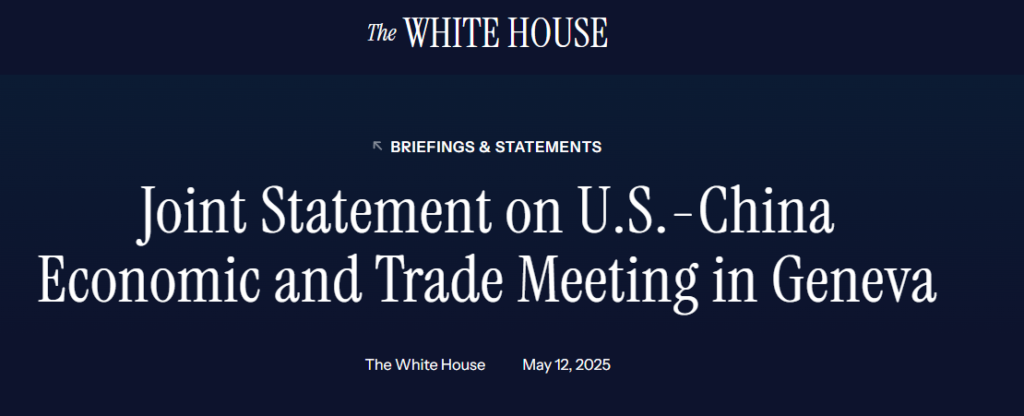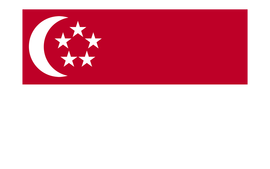Previous Docs #
On May 12, 2025, the United States and China issued a joint statement following economic and trade discussions in Geneva, marking a significant de-escalation in their ongoing trade tensions. The Joint Statement stipulates that, starting from May 14, 2025, both nations will suspend 24 percentage points of the additional ad valorem duties imposed on each other’s goods for an initial period of 90 days, while retaining a residual tariff rate of 10%. Furthermore, the Statement establishes a bilateral dialogue mechanism to continue discussions on broader economic and trade relations.


Key Provisions #
Tariff Adjustments by May 14, 2025: #
United States: #
Suspension of 24 percentage points of the additional ad valorem duties imposed on Chinese goods under Executive Order 14257 for an initial period of 90 days, while retaining the remaining ad valorem rate of 10 percent on those articles pursuant to the terms of said Order.
Removal of additional tariffs imposed by Executive Order 14259 of April 8, 2025 and Executive Order 14266 of April 9, 2025.
China: #
China will modify accordingly the application of the additional ad valorem rate of duty on articles of the United States set forth in Announcement of the Customs Tariff Commission of the State Council No. 4 of 2025, by suspending 24 percentage points of that rate for an initial period of 90 days, while retaining the remaining additional ad valorem rate of 10 percent on those articles
Removal of additional ad valorem rates of duty on those articles imposed by Announcement of the Customs Tariff Commission of the State Council No. 5 of 2025 and Announcement of the Customs Tariff Commission of the State Council No. 6 of 2025.
Suspension or removal of non-tariff countermeasures enacted against the United States since April 2, 2025.
Continued Dialogue: #
Both countries agreed to establish a mechanism for ongoing discussions on economic and trade relations, with meetings to be held alternately in the United States, China, or a mutually agreed third country. Representatives for these discussions will include U.S. Treasury Secretary Scott Bessent, U.S. Trade Representative Jamieson Greer, and Chinese Vice Premier He Lifeng.
Legal Analysis #
1. Temporary Nature of the Agreement:
The 90-day suspension of certain tariffs is a provisional measure, providing a window for both nations to address underlying issues in their trade relationship. The agreement does not constitute a permanent resolution, and the potential re-imposition of tariffs remains a possibility if further negotiations do not yield substantive outcomes.
2. Legal Implications for Trade Compliance:
Chinese companies must navigate the complexities of the adjusted tariff landscape, ensuring compliance with both domestic and international trade regulations. The suspension of certain tariffs and non-tariff measures necessitates a thorough review of existing contracts, supply chain agreements, and pricing strategies to align with the new trade environment.
Strategic Guidance for Chinese Enterprises #
1. Monitor Policy Developments:
Stay informed about ongoing negotiations and potential policy shifts by closely monitoring official communications from both the Chinese and U.S. governments. Timely awareness of changes will enable proactive adjustments to business strategies.
2. Diversify Markets and Supply Chains:
Reduce dependency on the U.S. market by exploring opportunities in other regions. Diversifying export destinations and supply chains can mitigate risks associated with bilateral trade tensions.
3. Strengthen Legal and Compliance Frameworks:
Enhance internal legal and compliance departments to ensure adherence to international trade laws and regulations. Regular audits and training can fortify the company’s ability to respond to regulatory changes.
4. Prepare for Scenario-Based Contingency Planning
Develop Response Playbooks: Prepare contingency plans for different policy scenarios, including tariff escalation, supply chain disruptions, and sanctions risks.
Conduct Stress Tests: Simulate business impacts under various tariff and regulatory scenarios to ensure operational resilience and financial stability.
Strengthen Legal Defenses: Engage professional legal counsel for potential trade remedy investigations (anti-dumping, countervailing duties) and compliance advisory.
Conclusion #
The Joint Statement from the U.S.-China Economic and Trade Meeting in Geneva represents a significant, albeit temporary, step towards easing trade tensions. While the 90-day suspension of certain tariffs offers immediate relief, the absence of a long-term resolution necessitates vigilance and strategic planning by Chinese enterprises. By proactively adapting to the evolving trade landscape, companies can position themselves for resilience and sustained growth amidst ongoing uncertainties.
This article is for informational purposes only and does not constitute legal advice. For case-specific consultation, please contact us. Read our full Legal Disclaimer, which also includes information on translation accuracy.












